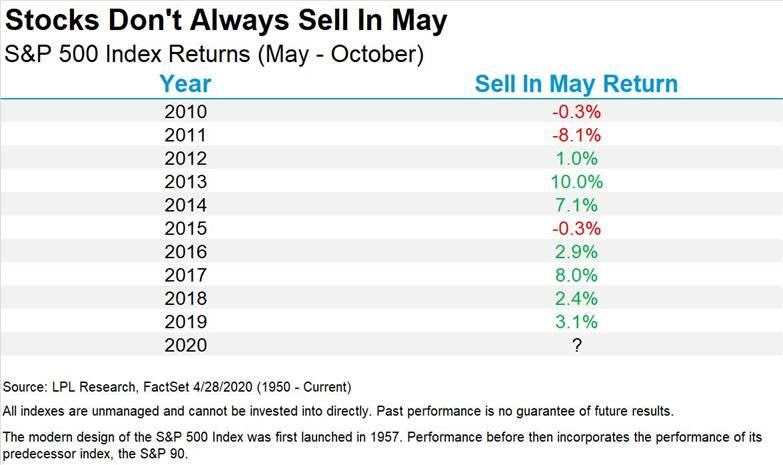Investing
Should You ‘Sell in May and Go Away’?

With the calendar rolling over to May, it’s time to take a look at one of Wall Street’s most well-known maxims and see if it makes sense this year.
“Sell in May and go away” refers to the seasonal pattern that the markets under-perform for the six months starting in May and ending in October.
This year, however, the decision to sell in May is complicated by the fact that stocks are coming off a massive rally in April and that momentum could easily carry over into May and possibly June.
In April, the Dow Jones Industrial Average gained roughly 11% and the S&P 500 gained almost 13%, the best overall monthly gains for both indexes since 1987 and their best April returns since 1938.
The Nasdaq gained more than 15% in April, its best overall monthly gain since 200 and highest monthly return ever.
These returns come as stocks have rocketed off their March 23 lows, now up more than 30% overall, and the country is slowly easing the “stay-at-home” orders that kept most of the economy shut down for the last month.
So should you sell in May, or stick around and see if April’s momentum helps push stocks even higher?
According to Jodie Gunzberg, chief investment strategist at Graystone Consulting, monthly S&P 500 data compiled from January 1928 through March 2020, which shows an average November-April return of 5.1%, versus just 2.1% for May-October.
Here are the historical returns when you look at the two six-month periods in both up and down markets:
- The November-April period delivered positive returns in 65 of 91 years (71%).
- The May-October period delivered positive returns in 60 of 92 years (65%).
- During positive periods, the average November-April return was 11%, versus 8.7% for May-October.
- During negative periods, the average November-April return was -9.6%, versus -10.4% for May-October.
Interestingly, the “sell in May” adage has been even less true recently. Over the last eight years, seven have produced positive gains during the six-month period from May through October. You can see those results in the chart below, compiled by LPL Financial.

Sam Stovall, the chief investment strategist at CFRA, a New York-based investment research company, says he is a “big believer” in the seasonal trend.
He cautions, however, that if you sit out the market altogether during the so-called “weaker” months, there’s a chance you could miss out on the occasional summer surge. Stovall suggests that Instead of completely exiting the market in May, you target defensive groups like consumer staples and healthcare from May through October.
Rick Swope, senior director of investor education at E*Trade Financial, warns against basing your investing decisions on a popular phrase, particularly in today’s environment.
“While some of the stats may hold true, timing the market based on a catch phrase is a losing game for long-term investors, especially as we face uncertain economic stability during the COVID-19 crisis.” Swope said.
Jodie Gunzberg of Graystone Consulting adds “We encourage our clients to stay invested according to their policies to meet their goals, which generally are not met by the timing adage ‘sell in May and go away,' but reflect needs for liquidity, inflation and retirement.”















